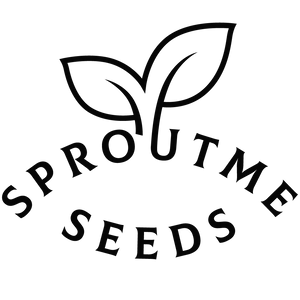Cilantro
Cilantro, also known as coriander, is a versatile herb commonly used in various cuisines around the world. It adds a distinctive flavor and aroma to dishes, making it a popular choice for home gardeners. Growing cilantro at home ensures a fresh and readily available supply for culinary uses.
Preparing for Growing:
- Selecting a planting location: Choose a spot with well-draining soil and partial shade, especially in warmer climates. Cilantro prefers cooler temperatures and can bolt quickly in hot, direct sunlight.
- Soil preparation: Prepare the soil by loosening it to a depth of about 8 inches and incorporating organic matter like compost to improve drainage and fertility.
- Purchasing or preparing containers/pots: If growing cilantro in containers, ensure they have drainage holes at the bottom and are at least 8-10 inches deep to accommodate the herb's root system.
Starting from Seeds Indoors:
- Seed preparation: Soak cilantro seeds in water overnight to help with germination.
- Choosing suitable pots/containers: Use seed trays or small pots filled with seed-starting mix.
- Sowing and caring for seeds indoors: Sow seeds thinly on the surface of the soil and cover lightly. Keep the soil consistently moist and place the containers in a warm, sunny location.
Starting from Seeds Outdoors:
- Soil preparation: Prepare the outdoor planting area as described earlier.
- Selecting appropriate timing and method for outdoor sowing: Plant cilantro seeds directly in the garden after the last frost date in your area. Scatter the seeds over the prepared soil and cover lightly with a thin layer of soil.
- Caring for seeds outdoors: Keep the soil evenly moist until seeds germinate, which usually takes 7-10 days.
Growing in Containers/Pots:
- Selecting suitable plants for containers: Choose compact cilantro varieties suitable for container growth.
- Container and soil preparation: Use well-draining containers filled with quality potting mix.
- Sowing or transplanting plants into containers: Sow seeds or transplant seedlings into containers following the same procedure as outdoor planting.
- Caring for container plants: Place containers in a location with partial shade and water regularly to keep the soil evenly moist.
Transplanting to Garden:
- Soil and planting site preparation: Choose a location with well-draining soil and partial shade.
- Correct timing and method for transplanting: Transplant seedlings outdoors after the last frost date, spacing them 6-8 inches apart.
- Post-transplant care: Water the transplanted seedlings thoroughly and provide shade during the hottest part of the day to prevent stress.
Plant Care:
- Watering: Keep the soil consistently moist but not waterlogged.
- Fertilizing: Apply a balanced fertilizer every 4-6 weeks or use compost to enrich the soil.
- Weeding: Regularly remove weeds to prevent competition for nutrients and water.
- Pest and disease management: Monitor for pests like aphids and caterpillars, and treat as needed with organic remedies. Watch for fungal diseases and ensure good air circulation around plants to prevent issues.
Harvesting:
- Determining when plants are ready for harvest: Harvest cilantro leaves when they reach a usable size, usually about 3-6 inches long.
- Harvesting and storage guidelines: Snip leaves as needed, leaving the central growing point intact for continued growth. Store fresh cilantro in the refrigerator, wrapped in a damp paper towel, or preserve by freezing or drying for future use.
When to Start from Seeds by USDA Plant Hardiness Zones:
- Cilantro is typically grown as an annual herb, and seeds can be sown outdoors after the last frost date in your area.
Fast Facts:
- Planting depth: Sow seeds ¼ inch deep.
- Seed spacing: Scatter seeds thinly or space them about 1 inch apart.
- Plant spacing: Thin seedlings to 6-8 inches apart.
- Number of seeds per pot/container: Sow several seeds per container and thin to the strongest seedling.
- Water preferences: Cilantro prefers consistently moist soil.
- Sun preferences: Partial shade is ideal, especially in warmer climates.
- Soil type and other important factors: Well-draining soil rich in organic matter is preferred.
- Companion Planting: Cilantro is believed to repel aphids and spider mites and is often planted near tomatoes, peppers, and other vegetables to deter pests.
- Temperature Preference: Cilantro grows best in cooler temperatures but can tolerate some heat if provided with adequate moisture.
- Days to Germination: Seeds typically germinate in 7-10 days.
- Days to Harvest: Leaves can be harvested within 3-4 weeks after sowing, while full maturity is reached in about 45-70 days.







